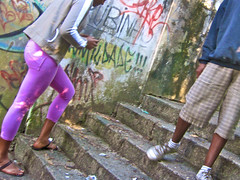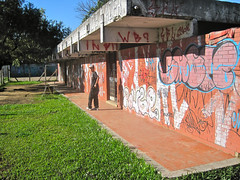I watched The Blind Side here in Brazil where it's titled O Sonho Possível (The Possible Dream). I get that it was based on a true story about football star Michael Oher, an African American who grew up in multiple situations of risk and vulnerability and was adopted in his late teens by an Anglo couple. However, there were a number choices made in the presentation and filming of this movie that made me disappointed, sad and angry.
One of the things that got to me was its depiction of neighborhoods. There was the rich neighborhood that the protagonists lived in - with its beautiful trees, enormous houses, white people and children who did all their homework. Then there were the housing projects on the other side of the tracks where the black people lived and where it appeared that no one ever laughed or was nice to each other. Just guns and drugs and violence and bad memories. So, uh, why did the director (and everyone else on board) chose to make these neighborhood realities so...black and white? Wasn't there some awareness of how awful and racist this comes across? Is this movie really saying that every single aspect of this young man's life was hellish before he came to live on the good side of town? That there was no good or beauty or love in his world?
And since I'm looking at strength-based and resiliency theories right now for a "Social Work Inventory" that I need to write for my last class of master's education, it's got me back thinking about this movie and how frustrating this all is. First off, I just find it hard to believe that this young man could have made it to his late teens and be the wonderful young man that he was if there hadn't been some special, nurturing people there at least at some points during his life. And some of those people likely would have lived in that housing project...and if that's the case, then there was some good and beauty there that the film doesn't show us.
The other aspect of this presentation of dichotomies (good/bad, safe/unsafe, etc.) when it comes to these two neighborhoods is that it doesn't create a space for the people who live in the unsafe neighborhoods to thrive and succeed. And then it blames them for the choices they are making without looking at potential root causes for those choices.
Here in Porto Alegre, it's true that there are a lot of neighborhoods that if people don't live in them, they are fearful of entering them. I can't imagine how on earth The Blind Side would choose to depict them, but it wouldn't be pretty. But real people live in them. And many of those people are the youth that I work with in my internship, youth that are in conflict with the law, for a variety of reasons. When I talk to these kids and ask them about the spaces where they feel safe, accepted and included they often mention their homes and their neighborhoods. The very spaces that so many people living outside of these neighborhoods think about in terms of fear.
The other day when we gave youth group #2 their cameras for the photo project, we all took a walk together through part of the area where they live. Of course this area is a mixture of the very rich and the very poor, almost side by side. And there were these beautiful praças [plaza/square/parks] shaded by trees that everyone uses. We were there playing and taking pictures. The more intrepid among us were also walking off the beaten paths into the woods where homeless encampments were located. Trash littered some areas showing signs of recent drug use. There was a beautiful field for soccer playing. The sky was blue. The sun was shining. The foliage was dense and green. I got to play the part of tourist and the kids showed me some of the beauty in where they lived. I took pictures but so did they and those are the pictures that will likely have much more to say.
And then they took their cameras back home for more picture-taking of their worlds through their eyes.
I know that I'm on my high horse here, full of indignation about a movie, comparing it to real life, which of course it is supposed to be based on. And I know that I'm coming from the space of a white girl who has lived a very sheltered, privileged life. I've had my white guilt phase and know that it's a place of paralyzed inaction. Looking at the world's issues and thinking "My God this is too much. It's too overwhelming. There's no way I can make a positive impact. I'm sorry!" Sometimes I still feel guilty, like when I pass the one-armed beggar on the street corner outside the pet store and he looks me in the eye and I don't want to give him money and I hate that I want to do something but don't know what. And I still perhaps try to take the easy way out. Even the easy way when it comes to discussing this movie. Normally I hold back my rants when I hear people gushing about it.
But, I have social work school to thank for the fact that I can no longer watch a movie in peace and blindly enjoy it. As well as for the knowledge that if I've got this privilege, then I better try damn hard to do something good with it. More than try, I better act.
Life is just never as simple and clear-cut as The Blind Side made it out to be. It frustrates me that the makers of that movie didn't think about representing any nuance or showing how much gray area there is in everything. But that of course begs the questions, who are the people who are telling the story and whose story are they actually telling?
Halloween 2017: The Ghost of Harry Houdini
-
The magician and escape artist Harry Houdini died in Detroit 91 years ago,
on Halloween. Before his death, Houdini had added "spiritual debunker" to
his re...
8 years ago







I hear you, BDG.
ReplyDeleteYou're all right.
J/K_lolz
Thanks for the visit and the read J/K_lolz :-)
ReplyDeleteThis is so wise and true, dear lady, and touches me deeply...
ReplyDeletehi lady! you can't feel guilty! in all the rest you are totally true!
ReplyDeletemovies are almost all back and white :(